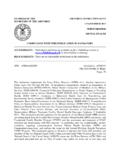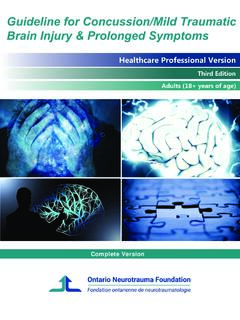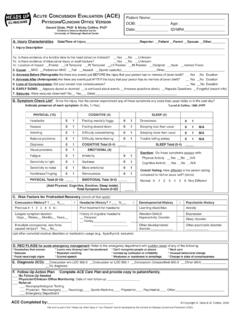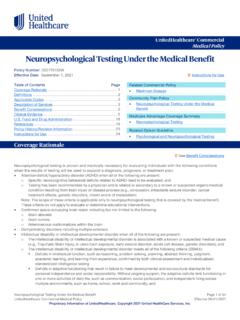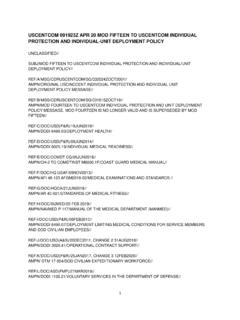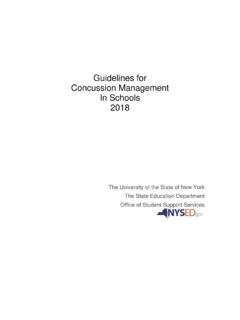Transcription of TRAUMATIC BRAIN INJURY GUIDELINE
1 TRIUMPH Tele-Rehabilitation Interventions through University-based Medicine for Prevention and Health TRAUMATIC BRAIN INJURY GUIDELINES 2020 TRIUMPH TRAUMATIC BRAIN INJURY GUIDELINES 2020 Copyright 2020 TRAUMATIC BRAIN INJURY GUIDELINE Altered Mental Status in the Patient with - TRAUMATIC BRAIN INJURY Author(s): Rani Lindberg, MD Peer Reviewed: Finalized: August 2020 Drafted: August 2020 Date: Published: 2020 I. Definition, Assessment, Diagnosis A. Definition: 1. Altered Mental Status (AMS): Alteration in level of consciousness as objectively measured by the Glasgow Coma Scale (GCS) < 15, assessing eye opening, best motor response, and verbal response (8) 2.
2 Level of Consciousness: Function of the pontine reticular activating system relating to both arousal (awareness of one s surroundings) and cognition (response to various stimuli) (8) 3. Neurologic deterioration: Decrease in GCS score by two or more points, pupillary abnormalities (fixed unilateral or bilateral pupils, anisocoria, mydriasis, slowed/ sluggish pupil constriction), focal neurological deficits, intracranial pressure (ICP) > 20mmHg (41, 42) a. Depressed, confusion, lethargy, obtundation, stupor, coma b.
3 Elevated, hypervigilance, agitation, insomnia, seizure B. Assessment: 1. History: a. Constitutional: Fatigue, lethargy, fever, changes in appetite, unintentional weight loss or gain b. Head/ears/eyes/nose/throat: Headache, diplopia, vision loss, hearing loss, drooling c. Cardiovascular: chest pain, heart palpitations, diaphoresis d. Respiratory: shortness of breath, cough e. Gastrointestinal: constipation, diarrhea, abdominal pain, emesis f. Genitourinary: urinary frequency, increased urinary volume, pain with urination, sexual dysfunction g.
4 Musculoskeletal: muscle or joint pain and/or swelling h. Integumentary: rash, acne, dry skin i. Neurological: mental status changes, lethargy, coma, increased tone and/or spasticity, increased muscle weakness, sensory loss, tremor, dizziness/vertigo, seizures j. Psychiatric: agitation, restlessness, mood lability k. Endocrine: temperature intolerance, changes in hair pattern and/or texture l. Hematologic/lymphatic: bruising, petechial lesions, bleeding m. History of Intracranial bleed (Subdural hematoma, epidural hematoma, subarachnoid hemorrhage, etc.)
5 N. Active medication review, recent changes, over the counter supplements 2. Physical Exam: a. Decrease in GCS by two points and/or altered level of consciousness, either depressed or elevated b. Pupillary abnormalities, including fixed unilateral or bilateral pupils, anisocoria, mydriasis, slowed/ sluggish pupil constriction, papilledema, nystagmus TRIUMPH Tele-Rehabilitation Interventions through University-based Medicine for Prevention and Health TRAUMATIC BRAIN INJURY GUIDELINES 2020 TRIUMPH TRAUMATIC BRAIN INJURY GUIDELINES 2020 Copyright 2020 c.
6 Focal neurologic signs, including cranial nerve, motor, sensory, or speech deficits d. Flexion or extension posturing e. Bradycardia and hypotension f. Hyperthermia (core temperature > C) or hypothermia (< 36 C) g. Hypoxia h. Abnormal respiration, increased or decreased respiratory rate i. Seizure(s) complete or partial (see Management of Seizures in the Patient with TRAUMATIC BRAIN INJURY GUIDELINE ) j. Altered level of consciousness, either depressed or elevated k. New or worsening ataxia l.
7 New or worsening cognitive impairment m. Tachycardia, palpitations n. Diaphoresis o. New or increased spasticity or muscular rigidity p. Shivering, tremor q. Jaundice r. Rash with or without pruritus s. Skin erythema, cellulitis, pain, purulent drainage 3. Laboratory test(s): a. Rapid glucose testing b. Complete blood count with differential c. Basic metabolic panel d. Urinalysis with urine culture e. Blood cultures f. Arterial blood gas (ABG) g. Lumbar puncture with cerebrospinal fluid (CSF) analysis h.
8 Serum and urine osmolality i. Serum and/or urine drug levels (therapeutic and recreational drugs) j. Coagulation panel k. Thyroid function panel l. Liver function panel m. Neuroendocrine labs: adrenocorticotropic hormone (ACTH), cortisol, growth hormone, insulin-like growth factor, prolactin, gonadotrophins and sex-steroid concentrations 4. Radiologic imaging /Other: a. Chest x-ray: Pulmonary pathology manifestations including, aspiration, pulmonary edema, consolidation pneumonia, effusion, and opacification b.
9 CT head scan without contrast: High sensitivity for demonstrating mass effect, midline shift, evidence of increased intracranial pressure, ventricular size and configuration, bone injuries, and acute hemorrhage in parenchymal, subarachnoid, subdural, or epidural spaces (7) c. MRI of BRAIN : High sensitivity for detecting non-hemorrhagic primary lesions, such as contusions, infarction, diffuse axonal INJURY (DAI), and secondary effects of trauma such as edema (7) d. EEG: Capture of abnormal BRAIN wave or epileptic activity.
10 C. Diagnosis 1. In patients with TRAUMATIC BRAIN INJURY (TBI), AMS can be defined as neurological deterioration relative to their baseline level of consciousness 2. The common causes of AMS in TBI patients occur in the following categories: TRIUMPH Tele-Rehabilitation Interventions through University-based Medicine for Prevention and Health TRAUMATIC BRAIN INJURY GUIDELINES 2020 TRIUMPH TRAUMATIC BRAIN INJURY GUIDELINES 2020 Copyright 2020 a. Intracranial complications 1. Recurrent or worsening intracranial bleeding (ICB) a.


